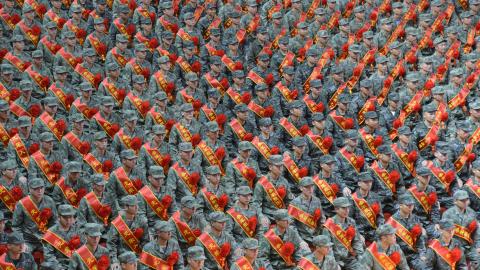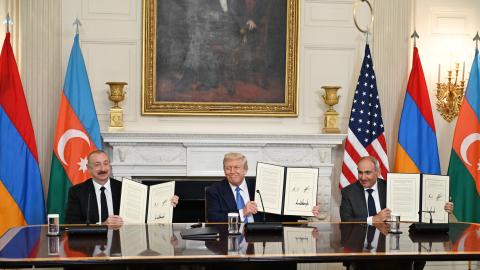We squeeze into the cramped rear seat of a green Ford Ranger Afghan National Police truck. Neither Air Force Lieutenant Colonel Andy Veres—the Provincial Reconstruction Team (PRT) commander—nor the State Department’s James Dayringer nor I wear the body armor and helmet that used to be mandatory for any trip outside the wire of American bases here. Yet we are about to drive 30 miles from the PRT in downtown Qalat to remote Arghandab District in an unarmored car.
On my previous visits to Zabul in November 2009 and April 2010, we would have had to go with a company of American maneuver troops in Humvees. This is Afghanistan’s second-poorest province, where the Taliban’s roots are deep. And while today’s trip takes three hours each way, a year ago it might have taken days, depending on how many IEDs were discovered and how many exploded.
In November 2009, there were weekly suicide attacks in Zabul’s biggest town, Shajoy (population 40,000). There hasn’t been one since May. The mobile phone towers used to be shut down by Taliban decree from sunset to sunrise; now they’re open.
The point of our trip is practical: to show Afghans that the road has been cleared of Taliban and is open for business. Veres—a tall, skinny recreational mountaineer with 65 marathons and ultramarathons under his belt—counts every commercial vehicle we pass along the way up to Arghandab. “Maybe there were 12 cars today. But as people learn the road is open, this will give them the opportunity to take their crops to market in Qalat.” There are now about 50 miles of paved road in Zabul besides the national ringroad, Highway One; there were none in 2007.
Veres’s remark echoes the results of a recent survey of 1,000 southern Afghan men by ICOS. They cited the main contribution of foreigners to Afghanistan as roads (74 percent), schools (53 percent), jobs (21 percent), and elections (9 percent), while only 1?percent said “removing the Taliban.”
The 60 or so Pashtun elders we meet in Arghandab are, according to the local Afghan National Army commander, all illiterate. The blanket and shawl distribution funded by the Americans is a big deal; the local bazaar has only two shops, one a butcher shop without any meat.
The struggle for places like Arghandab isn’t easy. But Zabul seems to be on an upward path. One reason is the growing competence of the Afghan National Army here. The notoriously intractable police are also coming along.
Imaginative programs have been pushed through by a series of good American commanders. A self-defense initiative by former Zabul commander Lieutenant Colonel David Oclander rewards Shajoy men who sign up to police the bazaar with $1,200 bonuses to start a business or join the security forces permanently. Veres—who also served as PRT commander here from June 2009 to March 2010—started a program that places Zabul high school graduates in provincial ministries on internships to help the under-educated directors do their jobs better. He’s part of the Afghan Hands program that aims at creating area experts in our military.
Another factor is the near-doubling of foreign troop strength in Zabul over the last 12 months. In June, 2nd Stryker Cavalry Regiment under Colonel James R. Blackburn arrived in Zabul, joining two Romanian battalions. While the Romanians train the Afghan National Army and protect Highway One, the Stryker battalion under the command of Lieutenant Colonel Omar Jones is responsible for the more dangerous outlying areas.
The security has been won at the cost of many lives. Since June, Jones has lost 3 of his 850, and 7 other American Special Forces were killed, along with 2 Romanian soldiers. The loss among the Afghan police and army here is high: 22 dead since June. Since then, between 24 and 40 IEDs have gone off every month.
The next day, I trail Veres and State Department representative Jesse Alvarado—in his second year here—as they spend the day with Shahr-e-Safa district governor Shadi Khan Nouri. A Kandahari with a ninth-grade education, Nouri owes his position to his long relationship with President Karzai. His three advisers, paid the locally munificent sum of $500 a month each by the U.S. government, do the job he isn’t qualified to do: paperwork, email, project assessment.
Why not just replace Nouri? Politically impossible: District governors are presidential appointees. A real villain, Mohammad Wazir, was evicted from one district for heroin-running and general evildoing after enormous effort by Oclander—only to be reassigned by Karzai to a different district. The tribal leaders there recently protested that they would drag him naked through the street if he dared return. Major Derrick Hernandez, who served under Oclander in Zabul, commented, “Just imagine how far along we would be if the people actually voted for their district and provincial leaders!” Commander Veres, on the other hand, cautions that Afghan voting is a work in progress, and elected district governors might not be any more capable, though they might better serve their local tribes.
And so it goes, in a struggle for governance, the rule of law, and civil society that can assume horrific or comic dimensions. As we walk with Nouri through the pitiful Shahr-e-Safa bazaar, we pass under the American-funded solar street lights, stripped of their solar panels by locals oblivious to the public good. “I won’t be in a hurry to replace these,” Veres says.
















